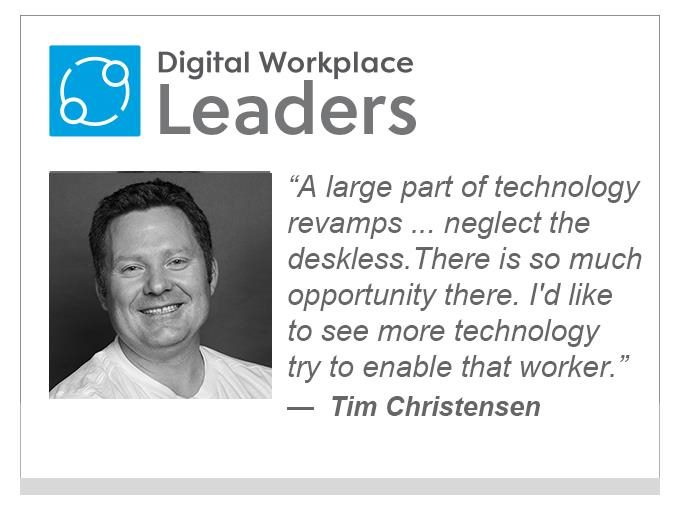

PHOTO:
Nana Smirnova
Software industry leader Tim Christensen is passionate about making the digital workplace experience better for a group of workers who are often disregarded: the deskless workforce. Many employees — including warehouse workers, nurses, truck drivers, firefighters and more — don’t work in an office and don’t have easy access to the latest computer software or technology that desk workers can rely on.
The CTO at SocialChorus, Christensen said a company should consider the needs of all workers when looking to adopt a new digital tool.
What the end users need is what’s important, he added. Figure out the key problems you’re trying to solve with software, find the best-in-class solution for that, and don’t look for a single solution to solve everything at once.
“Oftentimes with IT, one of their biggest risks is if they buy this software and they spend all this time and roll it out and no one uses it, it was a complete failure. So how do they get people to use it? Well, start from the user, then go to the software. Don’t start with the software and go to the user,” he said.
SocialChorus, the makers of the digital employee experience platform, FirstUp, is a sponsor at Digital Workplace Experience, taking place July 15 as an online event. We spoke with Christensen about the relationship between IT and HR, the importance of accessible technology and why CEOs should care about improving the employee experience.
Understand the Unique Needs of Your Employees
CMSWire: How do you engage employees on digital platforms rather than overwhelm them with too much information?
Tim Christensen: There are a number of challenges that exist today. Oftentimes, a lot of enterprise systems are siloed. And when you have tens and dozens of those systems, they’re all competing for the same attention.
You also have the challenge where [employers] treat everybody as resources. For them, the most important thing is just for people to read that communication. But for the receiver, they have 10 other priorities. There’s this neglect of what the individual needs — thinking of them as a resource versus thinking of them as an individual.
The last part is accessibility. Oftentimes when we think about technology, it’s like, ‘I’m going to send the email and everybody’s going to receive the email.’ But if you’re a truck driver, you don’t get those emails. If you’re a nurse, you may only have access to the kiosk.
How do we engage employees on digital platforms through all of those lenses? One is, put the end user at the center of the universe and deliver the right information to the right person at the right time. Understand that they all have unique needs.
CMSWire: If companies are trying to assess how successful their digital platforms are in engaging employees and not overwhelming them, how can they get that information and how can they assess how well they’re doing with this?
Christensen: What’s happening is people are just shifting from one technology to another. You see people saying, ‘I get too many emails. Email is dead.’ But then what they do is just move everybody to a collaboration platform, where they still have the same problem. And even to that extent, that’s still only thinking about the people that are in the office at the desk. You still have the person who’s at the checkout stand or who’s delivering groceries or who’s delivering mail. They’re not having email problems.
How do companies handle this better? One way is just understanding the end-user perspective. You have to have data. You have to be listening to the end user.
CMSWire: What does a healthy, productive partnership between HR and IT look like? What does an unhealthy one look like, and how can you begin to fix that?
Christensen: Both organizations have a desire to help the company. They want to drive the business. And so they’re looking at success through the lens of the objectives that have been set for them. So oftentimes when those two organizations come into conflict, it’s just because they have objectives that conflict.
If IT is told your information security is your top priority, then they’re going to make it harder for people to get access to information. If HR’s priority is to enable easy access to resources in the organization, then that’s going to conflict with IT. The same thing happens when one department is responsible for cutting costs and the other is responsible for delivering a better experience. Those two things are going to come in conflict.
When you have those conflicts, sit down and say, ‘How can these two objectives work together?’ It really starts with that conversation and asking, ‘Can our two objectives align?’
If the two organizations don’t align on a shared objective, then they’re always going to have that tension.
Why You Should Care About Improving Employee Experience
CMSWire: How can you help employees gain the digital skills that may be necessary for the job while still allowing them enough time to focus on tasks/jobs they need to do every day?
Christensen: I think the bigger challenge that I see is access to technology. If you think about the deskless workforce, a lot of them don’t have access to the same level of technology as the desk worker. If I work in a warehouse, I might have to keep my mobile phone in my locker. If I’m a nurse, my access to the company internet is through the kiosk on my floor.
Think about every worker. Whether you make it more mobile or get them on tablets or shared kiosks, make technology more accessible. People—as long as they don’t need to jump through five hoops to figure out how to use it — will figure out how to use it.
CMSWire: Do you think that companies are thinking about these deskless workers when they’re coming with tech solutions?
Christensen: Largely, no. For the most part it’s out of sight, out of mind. People thinking about the digital workplace are in the office, not in the field.
A large part of technology revamp efforts are positioned around the desk, and they’re neglecting the deskless. There’s so much opportunity there, and I’d like to see more technology try to enable that worker. Because the other thing is that there is not just one concept of a deskless worker. If I’m a truck driver, I have very different needs than a nurse, who has very different needs than a firefighter. So you still want to build software that serves these particular needs and not just clump them all together and say, ‘Those are for the deskless and those are for desk workers.’
CMSWire: Why should we care about improving the employee experience?
Christensen: There’s a lot of evidence out there that says putting your employees first leads to more profits and more success. But then the question is, ‘Can you prove it to me?’ [Regarding] software that cares about improving the employee experience, they’re going to have to do a better job of measuring impact.
A lot of people say, ‘How do you get feedback from people?’ There’s implicit feedback and explicit feedback. The implicit feedback is, ‘I’m just going to listen to and watch what you do.’ And this isn’t Big Brother watching but more like, which topics are of interest to people? What behaviors correlate to success in the organization?
In a great employee experience ecosystem, we’ll be measuring these signals, and then executives can use that data to create a better employee experience, which creates a better company. I think that the next wave of these platforms that are here to enable employees should also be listening to the implicit signals, not just the explicit signals, and then further improve the employee experience — and do it for every employee, whether they’re the desk or the deskless.
Claim your free pass to the Digital Workplace Experience here.
The events staff at Simpler Media Group, publisher of CMSWire and Reworked, work to inform our readers and community on our two conferences, the DX Summit and the Digital Workplace Experience. Find out everything you need to gear up for two of tech’s premiere events.




![20 Press Release Submission Websites List 2024 [Free & Paid]](https://bloggerspassion.com/wp-content/uploads/2024/04/press-release-websites-list.png)


